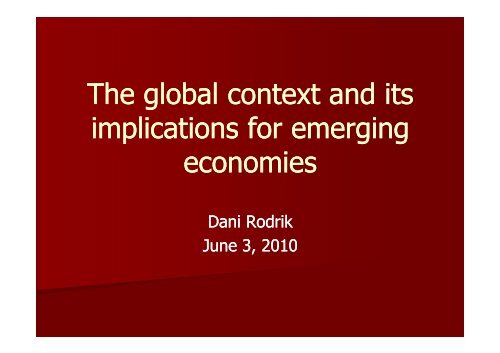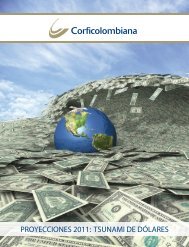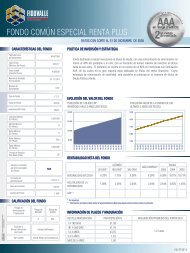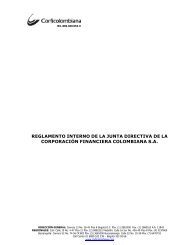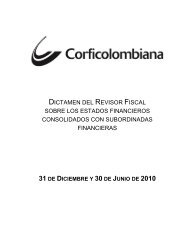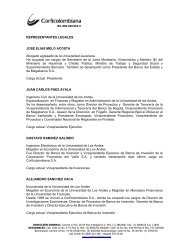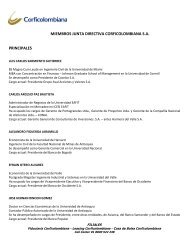(Microsoft PowerPoint - The global context and ... - Corficolombiana
(Microsoft PowerPoint - The global context and ... - Corficolombiana
(Microsoft PowerPoint - The global context and ... - Corficolombiana
You also want an ePaper? Increase the reach of your titles
YUMPU automatically turns print PDFs into web optimized ePapers that Google loves.
<strong>The</strong> <strong>global</strong> <strong>context</strong> <strong>and</strong> its<br />
implications for emerging<br />
economies<br />
Dani Rodrik<br />
June 3, 2010
<strong>The</strong> setting<br />
Financial stability is being restored in the advanced<br />
countries eventually<br />
Recovery is taking place, but economic growth in the<br />
advanced economies is likely to fall short from pre-crisis<br />
levels<br />
– sizable wealth destruction + burden of public debt => slow<br />
consumption growth<br />
– European crisis will exert continuing drag at best<br />
Political constituency for “economic openness” will<br />
remain weak at best in the advanced countries<br />
– Significant strains on world trade regime is likely<br />
So the pace of economic <strong>global</strong>ization is likely to slow<br />
down<br />
– Domestic markets <strong>and</strong> domestic growth strategies will become<br />
more important for the health of tradable industries
Incomplete economic recovery<br />
Real GDP, advanced economies (2000=100)<br />
120<br />
115<br />
110<br />
105<br />
100<br />
95<br />
90<br />
2000 2001 2002 2003 2004 2005 2006 2007 2008 2009 2010
Global trade unlikely to recover its<br />
previous buoyancy<br />
Global trade volume (2000=100)<br />
170<br />
160<br />
150<br />
140<br />
130<br />
120<br />
110<br />
100<br />
90<br />
80<br />
2000 2001 2002 2003 2004 2005 2006 2007 2008 2009 2010
Protectionist clouds on the horizon<br />
China’s surpluses <strong>and</strong> <strong>global</strong> macro imbalances<br />
– Even some distinguished free traders now favor<br />
punitive tariffs on China<br />
Excess capacity in many sectors<br />
– Steel: 19% <strong>global</strong> overcapacity in 2008 (MGI)<br />
Renewed emphasis of the role of government in<br />
the economy<br />
– Market fundamentalism is dead<br />
WTO <strong>and</strong> the multilateral trade regime in trouble<br />
for some time<br />
– Problems of over-reach reach <strong>and</strong> legitimacy
<strong>The</strong> good, the bad, <strong>and</strong> the ugly<br />
1. Managed <strong>global</strong>ization<br />
– Better balance between the prerogative of nation<br />
states <strong>and</strong> international rules<br />
2. Business as usual<br />
– Continued reliance on (necessarily inadequate)<br />
improvements in <strong>global</strong> governance <strong>and</strong><br />
coordination<br />
3. Return to the 1930s<br />
– Protectionist free-for<br />
for-all<br />
<br />
<strong>The</strong> first option is the only practical <strong>and</strong><br />
sustainable remedy for the world economy
A slower pace of <strong>global</strong>ization is<br />
not necessarily bad news<br />
Growth comes from convergence with the productivity<br />
level (the “technology”) that prevails in the rich countries<br />
– <strong>The</strong> stock of ideas <strong>and</strong> knowledge that constitutes<br />
“technology” does not disappear or dissipate when rich<br />
countries grow more slowly or when world trade is less buoyant.<br />
Countries of the Latin American region grew more<br />
rapidly prior to the 1980s than they have since<br />
For countries with large domestic/regional markets<br />
domestic market growth can sustain rapid increase in<br />
output in tradables
Comparative economic performance<br />
of Latin America by periods<br />
8<br />
7<br />
6<br />
Annual average growth rate of GDP per capita<br />
5<br />
4<br />
3<br />
2<br />
1<br />
East Asia<br />
Advanced economies<br />
Latin America<br />
0<br />
1960-1980 1980-1990 1990-2008<br />
-1<br />
-2
Comparative economic performance<br />
of Colombia<br />
8<br />
7<br />
6<br />
Annual average growth rate of GDP per capita<br />
5<br />
4<br />
3<br />
2<br />
1<br />
East Asia<br />
Advanced economies<br />
Latin America<br />
Colombia<br />
0<br />
1960-1980 1980-1990 1990-2008<br />
-1<br />
-2
<strong>The</strong> long view on economic growth:<br />
what’s <strong>global</strong>ization’s contribution?<br />
Historical experience with growth<br />
9<br />
8<br />
GDP per capita growth rate of fastest growing<br />
country/region (annual average, %)<br />
World GDP per capita growth rate (annual<br />
average, %)<br />
7<br />
6<br />
5<br />
4<br />
3<br />
2<br />
1<br />
0<br />
1000-1500 1500-1820 1820-1870 1870-1913 1913-1950 1950-73 1973-90 1990-2005<br />
Western Europe United States Other Western<br />
offshoots<br />
Mexico Norway Japan South Korea China
What drives growth in developing<br />
Three models of growth:<br />
countries?<br />
1. Foreign borrowing-led growth<br />
• countries in the periphery of EU in 1990s, LA in 1970s, …<br />
2. Commodity booms<br />
• 19th century, many African countries in the last decade<br />
3. Structural transformation-led growth<br />
• From low-productivity traditional products to modern, mostly<br />
manufacturing activities (<strong>and</strong> lately increasingly into tradable<br />
services)<br />
• Based not on (static) comparative advantage, but on producing<br />
what richer countries produce<br />
Only the last has been a sustained source of convergence<br />
(Japan, S. Korea, China)
Countries that rely less on external<br />
resources grow faster in the longer term<br />
Source: Prasad, Rajan, <strong>and</strong> Subramanian (2006).
Can Latin America return to rapid<br />
growth? Pluses<br />
Growth potential, as measured by “convergence<br />
gap” with advanced countries, larger than ever<br />
since the early 1970s<br />
Significant capacity to absorb (<strong>and</strong> generate)<br />
new technologies<br />
Much greater integration in international trade<br />
<strong>and</strong> production networks<br />
Better macroeconomic management<br />
Improved governance <strong>and</strong> institutions
Can Latin America return to rapid<br />
growth? Minuses<br />
Endemic tendency for high real interest rates<br />
– A consequence of history of fiscal imprudence <strong>and</strong><br />
macroeconomic instability<br />
Much greater integration in <strong>global</strong> finance<br />
– Sudden stops <strong>and</strong> financial whiplash<br />
– Currency overvaluation as soon as optimism sets in<br />
Much greater conflict between “productivist” <strong>and</strong><br />
finance-centered centered policies<br />
– Should monetary policy target purely inflation or take into<br />
account competitiveness <strong>and</strong> employment too?<br />
– Should capital inflows be allowed to lead to currency<br />
appreciation or result in sterilization <strong>and</strong> capital controls?<br />
– Is there a role for industrial policies?
What has worked in East Asia:<br />
“productivist” policies<br />
Sound “fundamentals”<br />
– Market-friendly policies<br />
– Macro stability<br />
But also:<br />
– Industrial policies in support of new economic<br />
activities<br />
– Undervalued currencies to promote tradables<br />
– (<strong>The</strong> more a country relies on industrial policies, the<br />
less the need for currency undervaluation, <strong>and</strong> vice<br />
versa)<br />
– A certain degree of repression of finance, to enable:<br />
Development banking<br />
Subsidized credit<br />
Undervaluation
… combined with an enabling<br />
external environment<br />
Permissive with regard to industrial policies<br />
– At least under GATT <strong>and</strong><br />
– Until recently<br />
Willing to absorb excess supply of tradables<br />
– U.S. attitude of benign neglect towards current<br />
account deficits<br />
Bretton Woods I <strong>and</strong> II<br />
– Unconcerned with undervaluation in developing<br />
countries<br />
Again, until recently
Latin America cannot duplicate Asia<br />
History of macroeconomic instability<br />
Financial <strong>global</strong>ization<br />
Global trade rules
But it can internalize the main<br />
lessons<br />
Economic transformation requires strategic<br />
collaboration between the private sector <strong>and</strong> the<br />
government<br />
– Instead of a h<strong>and</strong>s-off approach<br />
– Important role for “industrial policies”<br />
Currency volatility <strong>and</strong> overvaluation is very<br />
harmful to economic development<br />
– Role of capital controls<br />
Only high levels of domestic saving can reduce<br />
the economy’s reliance on capital inflows without<br />
hurting investment <strong>and</strong> growth<br />
– Role of strong fiscal policy


